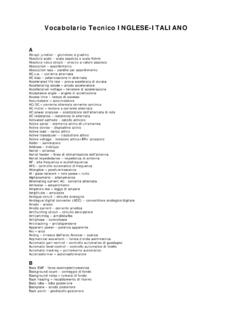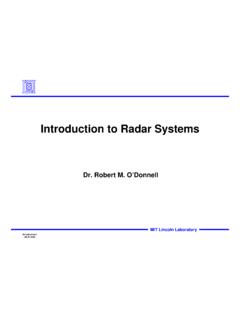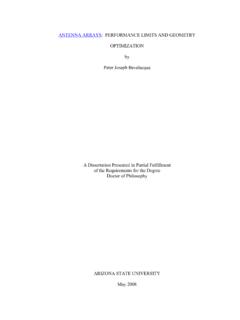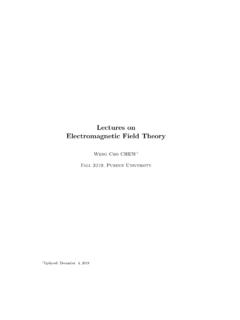Transcription of Building an End Fed Antenna
1 Building an End Fed Antenna By Eugene Morgan In this article I will cover several topics given that the subject is about Building an Antenna System and not just the Antenna . There are four specific areas we will dive into, the first is the Antenna , the second baluns, the third chokes, and lastly the transmission line. All of these items are necessary in virtually every Antenna installation regardless if it s a simple vertical, dipole or a multi element parasitic array such as a Yagi. This article will focus mainly on the Antenna we built at Alan Parks, N7 SHA, QTH. But the techniques used are applicable to any Antenna installation. However we will focus on the specific of an end fed wire which apply to all end fed wires regardless of length. After doing a survey of Alan s yard we determined that the easiest Antenna and perhaps the most effective Antenna we could deploy was an end fed wire.
2 His yard was perfect for such an installation. He has a deep back yard surrounded by many tall trees with his house sitting near the front of the lot. We determined that we could run a wire over 180 feet into one of the tall trees in his back yard. The far end would be close to 50 feet high and the other end would terminate at end of his house and be connected to the electrical mast where the power comes into his house. That end would be about 20 feet in the air. Our first challenge was of course getting the far end of the wire into the tree. Climbing was out of the question. So we built an Antenna Canon. The Antenna canon is very simple design requiring only a saw and a drill. We were able to acquire the PVC and valve from the local Lowes and the gauge and valve stem at the Auto parts store. The air pressure gauge is optional.
3 We will not go into the construction of the canon but a picture has been provided, see Figure 1 and can provide an easy example to follow. The canon is made from 2 PVC and a length of PVC for the barrel. The valve is a gas line ball valve. The reel is an old fishing reel wound with 50 lb. Spider wire. Important note: Monofilament fishing line is not the best choice given its tendency to twist and tangle. The spider wire on the other hand is a braided fishing line that is a lot less prone to tangling and for its size it is very strong. For weights we use 2oz. egg sinkers. I painted them bright yellow to make them easy to spot. Total cost for the Antenna canon was $31 not including the fishing real or line, which we already had. Although it took us several tries we were able to get the line where we wanted it. After placing the line we pulled up progressive stronger line until we had a final haul line in place which was a 50 length of mountain climbing rope.
4 The key consideration is the abrasion the haul line will take. Climbing rope is a good choice given it s resistance to abrasion, its ability to stretch, and its larger diameter. We understand that not everyone has a bit of old climbing rope laying around. The key thing is to use as large a line as possible, not so much for its strength but for its resistance to wear. If climbing the tree is an option then inserting the haul line through a small bit of garden hose can be employed to minimize wear on both the haul rope and the tree. This is the technique we used at N7 KID s installation. To the haul line we tied a small carabiner that we used to run our halyard through. This made it possible to lower or adjust the Antenna without disturbing the haul line. We will readjust the haul line from time to time in order to move the wear spot.
5 By using the halyard we can readjust the Antenna as needed without putting any stress on the tree. See Figure 2 for details of how we rigged the haul line and Antenna halyard. Figure 1: The Air Powered Antenna Canon Figure 2: Line configuration Now that the Antenna is in the tree and the other end is tied off to the house it s now time to focus on connecting the Antenna to radio. How Long Should My Wire be? We started off the article with how to install an end fed wire but we kind of skipped over figuring out how long a wire to put up. The table below should help to fill in that gap. It presents a number of options. I have personally built three of these Antenna . The first was Alans (N7 SHA) which we didn t measure but I suspect it would be in the 173 range. The second, was Bruce s, (N7 KID) which we carefully cut to 85 with over 65 of feed line and finally my Antenna at 203 feet, however my feedline is only 90 long.
6 I took careful measurement of my Antenna and here are the results: Freq. SWR @ Radio :1 :1 :1 :1 :1 :1 :1 Table 1:SWR Results with 203' wire with 90' feedline The SWR was fairly close to predictions with the exception of 160 meters. Here the SWR was higher than expected, but still within range of the tuner in my Yaesu FT-950. I suspect the reason for the higher than expected SWR was a less than optimum feedline length, the recommended length is 130 . Fortunately the line loss on 160 meters with a : SWR across 90 of RG8 (.6dB loss at 10mhz per 100 ) is calculated to be only .28dB. Remember that 6 dB = 1 S unit on a properly calibrated S meter. So the loss will be virtually undetectable. The loss on 10 meters will be a bit higher at , which is still undetectable on the normal S meter. Table 2: Optimum wire and feedline lengths SWR for all lengths should typically be under :1 and in most cases will be under :1 for 160-10m which will allow most built in ATU s to match the Antenna on all bands.
7 Initial installation should utilize a length longer than the recommended length shown. Experimenting by slightly changing the wire length (+ or -) is encouraged to provide best overall performance for individual installations. If you can get the length close enough that your tuner can establish a conjugate match on each target band should be good enough. Remember that one S unit on your S meter is equal to 6 dB. At HF the difference between a 2:1 and a 3:1 SWR is virtually undetectable. As you can see from the above dimensions you don t need a massive lot or a small farm to erect an end fed wire Antenna . One can install an end fed wire in an attic or even on a small urban lot. Also, an end fed wire is a much simple Antenna especially when compared to something like a G5RV which requires the use of twin lead, which can extremely problematic in an attic space and highly susceptible to RFI.
8 I think the end fed wire has gotten a bad rap because they are usually not properly installed with the necessary unun and choke. How to Feed an End Fed Wire? The Balun or in this case the Unun The end fed wire regardless of its length presents a high impedance to the feedline. If the intention is to build a wave mono band Antenna then it is necessary to attach a 48:1 unun at the feed point given the extremely high impedance. But if it s a multi band Antenna and is not wavelength long on any of the intended bands then a 9:1 unun is necessary. Why an Unun? Typically we find two kinds of impedance transformers, balanced and unbalanced. Given that today nearly all antennas used by the ham community are fed with 50 ohm coaxial cable. In addition a balun is often used to connect then unbalanced coaxial cable to a semi balanced Antenna .
9 You will note that throughout I use the term (semi) balanced Antenna . The reason for this is that in reality the only really balance Antenna is one that exists in free space. Antenna unbalance is caused by Bands Covered (meters) Wire Length (feet) Minimum Coax Length (feet) 40-30-20-15 35-43, 49-63, 70-85 35 40-30-20-17 35-45, 54-64, 67-77 35 80-40-30-20-17-15-12-10 38-44, 55, 60, 68-73 50 80-60-40-30-20-17-15-12-10 55, 68-73, 85, 92, 102, 120-125 65 160-80-40-30-20-17-15-12-10 135, 141, 173, 203 130 all those things that surround an Antenna , buildings, trees, powerlines, fences, cars, and so on. In theory antennas, like dipoles and Yagi s, are consider balanced antennas, unless they are up high and in the clear there will be some level of unbalance in the Antenna . As you will see in the next paragraph these imbalances can cause problems that in some cases is very noticeable and in other instances can be very subtle.
10 Coaxial cable is considered an unbalanced feed system. So if you attach an unbalance feed line to a (semi) balance Antenna such as a dipole or Yagi you will get unpredictable and often unreliable and more importantly undesirable results, that are caused by common mode currents. Common mode currents on the feed line can manifest themselves in a variety of really icky ways. In worst case scenarios they can invade your shack and cause all sorts of issues with RF noise, electrical shocks, and computer mice and wireless routers that behave erratically. A much harder condition to detect is when the coaxial cable is acting like an Antenna on both transmit and receive! On transmit the radiation pattern may be off, the SWR unnecessarily higher than it should be and worst of all, some of that precious RF power is being radiated where it shouldn t be radiated.





